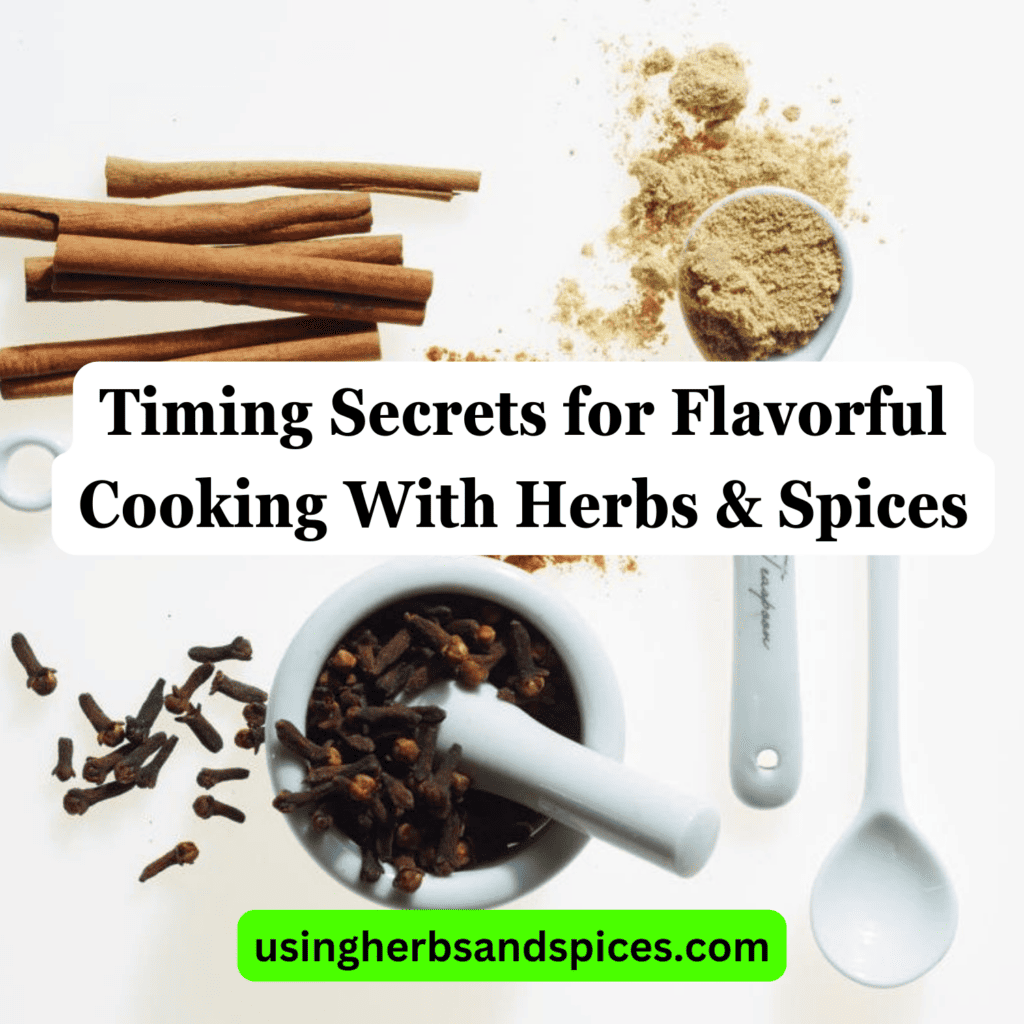In the kitchen, herbs and spices are the soul’s whispers, transforming simple ingredients into a symphony of flavors. You’re part of a community that cherishes the alchemy of cooking, where every pinch and sprinkle is an invitation to a richer tapestry of taste. Let’s unravel the secrets together, shall we?

Timing is your silent partner in this dance, as crucial as the spices themselves. You’ll learn when to introduce whole spices to the warmth of the pan, allowing their essences to bloom. You’ll discover the precise moment for ground spices to release their vibrant character without losing their spirit. And you’ll master the delicate art of weaving in fresh herbs so they share their fullest expression.
With these skills, you won’t just cook; you’ll craft lasting memories around the table. Welcome to the inner circle of flavor artisans.
Table of Contents
Key Takeaways
- Proper application of heat unlocks the aromatic release of herbs and spices.
- Delicate herbs like cilantro and parsley should be added just before serving.
- Add ground spices early in the cooking process for hearty dishes.
- Fresh herbs should be added at the end of cooking or just before serving.
Understanding Heat’s Role
Considering heat’s transformative power, you’ll find that mastering when to add herbs and spices is crucial for unlocking their full flavor potential in your dishes. The heat sensitivity of these botanical additives isn’t to be overlooked. Many herbs and spices contain volatile oils, which are responsible for their distinct aromatic release. When you apply heat properly, you coax out these captivating aromas and flavors, which bond with the other elements of your dish, creating harmony on your palate.
Hardy herbs like rosemary and thyme relish the slow coaxing of flavors that comes with prolonged cooking. They’re your stalwart companions in stews and roasts, where heat works its magic over time.
On the other hand, delicate cilantro and parsley are at their best when they’re added just before serving. Their fragile essences are no match for high heat, which can mute or completely dissipate their fresh, vibrant notes.
Whole Spices Infusion
In your quest for depth of flavor, don’t overlook the technique of infusing whole spices into your dishes, a method that slowly releases their complex profiles into the cooking medium. Mastering spice toasting techniques is essential.
Start by gently warming whole spices in a dry pan. This heat coaxing unlocks the oils and aromatics tucked within, heightening their intrinsic flavors.
Once toasted, you’re ready to delve into oil infusion basics. Choose a carrier oil with a neutral profile to ensure the spices take center stage. Add the whole spices to the warm oil and maintain a low, steady heat. Too high, and you risk burning the spices, losing their nuanced character and, with it, their ability to invite you into an aromatic embrace that only well-executed infusion can offer.
Patience is your ally here. Allow the spices to mingle with the oil, infusing it over time. This slow dance ensures that every note of the spice is captured, creating an oil that’s rich with the essence of the spice.
Use this oil to cook, dress, or finish your dishes, welcoming every member at your table into a shared experience of culinary warmth and flavor.
Ground Spices Timing
Having mastered the art of whole spice infusion, you’ll find that the incorporation of ground spices requires a different, yet equally deliberate, approach to timing for maximum flavor. The finesse of adding ground spices lies in understanding their potency and how quickly they can release their essence into your dishes.
Here’s how to deftly handle these aromatic powders:
- Early Addition: For hearty dishes like stews or curries, add ground spices early in the cooking process. This allows their flavors to meld and deepen as the dish simmers.
- Last Minute Sprinkle: When making quick-cooking items, such as stir-fries or sautéed vegetables, sprinkle ground spices towards the end to preserve their vibrant notes.
- Toasting Trick: Briefly toast ground spices in a dry pan before adding them to your recipe. This step can unlock hidden layers of flavor, perfect for spice blends.
- Storage Savvy: Keep ground spices in airtight containers, away from light and heat. Freshness is key, so use them within six months for peak flavor; heed these storage tips to avoid dullness.
Fresh Herbs Integration
Shift your focus to fresh herbs, which require a distinct touch; you’ll want to add them at precise moments to capture their delicate essence in your cooking. Mastering the integration of these aromatic wonders elevates your dishes from good to unforgettable.
Let’s dive into the world of herb chopping techniques and seasonal herb selection, ensuring you’re adept at making the most of what each herb offers.
When it comes to herb chopping techniques, you’re not just prepping ingredients; you’re unlocking flavors. Use a sharp knife and a quick, rocking motion to avoid bruising the leaves, which can lead to flavor loss. For herbs with sturdier stems like rosemary or thyme, strip the leaves off before mincing.
Seasonal herb selection is equally crucial. Embrace the herbs that are at their peak, as they’ll provide the best flavor for your dishes. In summer, basil and cilantro thrive, while in cooler months, reach for hardy options like sage and rosemary. By choosing herbs that naturally complement the season, your cooking will resonate with the rhythm of the natural world, nurturing a sense of connection and belonging with every bite.
Dried Herbs Best Practices
Dive into using dried herbs, and you’ll unlock a world of concentrated flavors that can withstand longer cooking times. When you’re ready to infuse your dishes with these potent aromatics, remember that how you store and pair them is crucial to the culinary alchemy you’re about to perform.
Here’s how you can master dried herbs in your kitchen:
- Proper Herb Storage: Keep your dried herbs in a cool, dark place, away from heat and moisture, to preserve their essential oils and potency. This will ensure that when you reach for that jar of rosemary or thyme, it will deliver its full aromatic punch.
- Timing is Key: Add dried herbs early in the cooking process. Their concentrated flavors need time to mellow out and infuse the dish, especially in soups, stews, and sauces.
- Crush to Release Flavor: Before adding them to your pot, gently crush dried herbs between your fingers. This act releases their essential oils, heightening the flavor profile of your dish.
- Mindful Aromatic Pairings: Consider the flavor profiles of your dried herbs and how they complement other ingredients. For instance, oregano pairs beautifully with tomatoes, while rosemary enhances the taste of roasted meats.
Finishing Touches Mastery
While you’ve masterfully incorporated dried herbs during cooking, don’t underestimate the transformative power of fresh herbs as a finishing touch to elevate your dishes. Fresh herbs not only add a vibrant visual appeal, but their aromatic garnishing can be the difference between a good meal and a culinary revelation.
Consider fresh basil on a Margherita pizza just out of the oven, or a sprinkle of dill atop a steaming salmon fillet. These aren’t mere decorations; they’re essential components for layering flavors, creating a complexity that your palate appreciates in the final stages of tasting.
To master the art of finishing touches, always remember that less is often more. A final sprinkle of cilantro can awaken the hidden depths of a curry, while a touch of tarragon might bring a creamy soup to life. Fresh herbs should be added at the very end of cooking or just before serving to preserve their delicate essence and prevent wilting.
By integrating this nuanced approach, you’ll find yourself part of a community that values the subtle yet significant impact of well-timed herbaceous enhancements. Your dishes will resonate with a symphony of flavors that only true connoisseurs can craft.
Welcome to the circle of culinary artisans who know that the final flourish matters just as much as the foundational ingredients.
Frequently Asked Questions
How Can I Store Herbs and Spices to Maintain Their Flavor for as Long as Possible?
To maintain their flavor, store your herbs and spices in airtight containers, properly labeled, away from light exposure. This ensures they’ll stay fresh and potent, making you the go-to flavor master.
Are There Any Health Benefits or Risks Associated With Using Herbs and Spices in Cooking?
Yes, you’ll find that herbs and spices can offer health benefits, such as antioxidants, but be mindful of herb interactions and always consider spice shelf life for both safety and maximum efficacy.
Can You Provide Tips for Growing Your Own Herbs for Cooking Purposes?
You’ll thrive by planting herbs together that benefit each other; it’s called herb companion planting. Also, cultivate your indoor herb garden to always have fresh flavors at your fingertips. You’re part of a community.
How Do I Substitute Fresh Herbs for Dried Herbs, or Vice Versa, in a Recipe?
You’ll master the art of substitution with a pinch of knowledge. Generally, use three times the amount of fresh herbs as dried, considering flavor intensity. You’re not just cooking; you’re crafting a community.
What Are Some Uncommon or Underutilized Herbs and Spices That Can Bring Unique Flavors to My Dishes?
Exploring Grains of Paradise, you’ll find they add a peppery zest, while Lovage Leaves usage imparts a bold celery-like flavor, making your dishes stand out in any food-loving community.
Flavorful Cooking using Herbs & Spices
In cooking, timing isn’t just everything—it’s the only thing. Remember, whole spices need a warm-up, ground spices demand punctuality, and fresh herbs crave a grand finale.
Dried herbs? They’re marathon runners, thriving on a lengthy simmer. As you master these finishing touches, you’ll be painting with flavor, not just cooking.
So trust your instincts, respect the clock, and let your dishes sing with layers of aromatic perfection. After all, ‘A watched pot never boils,’ but a well-timed one creates wonders.
